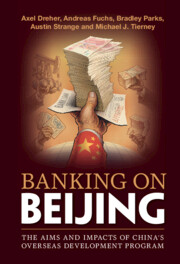Book contents
- Banking on Beijing
- Banking on Beijing
- Copyright page
- Contents
- Figures
- Tables
- Acknowledgments
- Abbreviations
- 1 Why Do We Know So Little about the Aims and Impacts of China’s Overseas Development Program?
- 2 The Journey to Global Creditor
- 3 Counting and Comparing Apples and Dragon Fruits
- 4 Follow the Money
- 5 Apples and Dragon Fruits
- 6 Aid à la Carte
- 7 Paving the Way to Growth and Development?
- 8 Poisonous Dragon Fruits?
- 9 Banking on the Belt and Road
- Postscript: Analysis of China’s Overseas Development Program During the BRI Era With an Updated Dataset
- References
- Index
3 - Counting and Comparing Apples and Dragon Fruits
Published online by Cambridge University Press: 21 April 2022
- Banking on Beijing
- Banking on Beijing
- Copyright page
- Contents
- Figures
- Tables
- Acknowledgments
- Abbreviations
- 1 Why Do We Know So Little about the Aims and Impacts of China’s Overseas Development Program?
- 2 The Journey to Global Creditor
- 3 Counting and Comparing Apples and Dragon Fruits
- 4 Follow the Money
- 5 Apples and Dragon Fruits
- 6 Aid à la Carte
- 7 Paving the Way to Growth and Development?
- 8 Poisonous Dragon Fruits?
- 9 Banking on the Belt and Road
- Postscript: Analysis of China’s Overseas Development Program During the BRI Era With an Updated Dataset
- References
- Index
Summary
Social science research on the aims and impacts of Chinese development finance remains in its infancy because Beijing shrouds its overseas portfolio of grants and loans in secrecy. This chapter introduces the Tracking Underreported Financial Flows (TUFF) methodology that the authors have developed to assemble a comprehensive dataset of Chinese aid and debt-financed development projects around the globe. It also provides an overview of previous attempts to quantify Chinese development finance, and explains how the authors’ methods and data are different from those of others. This chapter also tests whether an alternative approach—field-based data collection—might yield more useful and reliable re- sults. Drawing upon evidence from a “ground-truthing” exercise in Uganda and South Africa, the authors demonstrate that field-based and TUFF-based data collection methods produce similar results. However, the TUFF methodology is less vulnerable to detection bias and more readily scalable than field-based data collection.
- Type
- Chapter
- Information
- Banking on BeijingThe Aims and Impacts of China's Overseas Development Program, pp. 64 - 96Publisher: Cambridge University PressPrint publication year: 2022

